Exploring Signals for a Nuclear Future Using Social Big Data
Abstract
1. Introduction
2. Methodology and Data Mining
2.1. Methodology
2.2. Text Mining and Verification of the Methodology
3. Results
3.1. Analysis 1 (2005–2010)
3.2. Analysis 2 (2011–2017)
3.3. Analysis 3 (2017–2018)
4. Conclusions
5. Discussion and Implication
Author Contributions
Funding
Conflicts of Interest
References
- Georghiou, L. The Handbook of Technology Foresight: Concepts and Practice; Edward Elgar Publishing: Cheltenham, UK, 2008. [Google Scholar]
- Son, H. The history of Western futures studies: An exploration of the intellectual traditions and three-phase periodization. Future 2015, 66, 120–137. [Google Scholar] [CrossRef]
- Burns, A. Business intelligence. In Proceedings of the Paper Presentation to Australian Foresight Institute at Victoria, Australia; Swinburne University: Melbourne, Australia, 2003. [Google Scholar]
- Cornish, E. The Study of the Future: An Introduction to the Art and Science of Understanding and Shaping Tomorrow’s World; Transaction Publishers: New Brunswick, NJ, USA, 1977. [Google Scholar]
- Tolon, K. Futures studies: A new social science rooted in Cold War strategic thinking. In Cold War Social Science; Springer: New York, NY, USA, 2012; pp. 45–62. [Google Scholar]
- Venkatraman, N. Research on MIS Planning: Some Guidelines from Strategic Planning Research. J. Manag. Inf. Syst. 1985, 2, 65–77. [Google Scholar] [CrossRef]
- Feldman, R.; Sanger, J. The Text Mining Handbook: Advanced Approaches in Analyzing Unstructured Data; Cambridge University Press: Cambridge, UK, 2007. [Google Scholar]
- Sobkowicz, P.; Kaschesky, M.; Bouchard, G. Opinion mining in social media: Modeling, simulating, and forecasting political opinions in the web. Gov. Inf. Q. 2012, 29, 470–479. [Google Scholar] [CrossRef]
- Carrington, P.J.; Scott, J.; Wasserman, S. Models and Methods in Social Network Analysis; Cambridge University Press: Cambridge, UK, 2005. [Google Scholar]
- Park, C.; Yong, T. Prospect of Korean nuclear policy change through text mining. Energy Procedia 2017, 128, 72–78. [Google Scholar] [CrossRef]
- Cohen, A.M.; Hersh, W. A survey of current work in biomedical text mining. Briefings Bioinform. 2005, 6, 57–71. [Google Scholar] [CrossRef]
- Yoon, B.; Park, Y. A text-mining-based patent network: Analytical tool for high-technology trend. J. High Technol. Manag. Res. 2004, 15, 37–50. [Google Scholar] [CrossRef]
- Netzer, O.; Feldman, R.; Goldenberg, J.; Fresko, M. Mine Your Own Business: Market-Structure Surveillance through Text Mining. Mark. Sci. 2012, 31, 521–543. [Google Scholar] [CrossRef]
- Li, X.; Sun, S.X.; Chen, K.; Fung, T.; Wang, H. Design Theory for Market Surveillance Systems. J. Manag. Inf. Syst. 2015, 32, 278–313. [Google Scholar] [CrossRef]
- Lash, M.T.; Zhao, K. Early Predictions of Movie Success: The Who, What, and When of Profitability. J. Manag. Inf. Syst. 2016, 33, 874–903. [Google Scholar] [CrossRef]
- Corizzo, R.; Pio, G.; Ceci, M.; Malerba, D. DENCAST: Distributed density-based clustering for multi-target regression. J. Big Data 2019, 6, 43. [Google Scholar] [CrossRef]
- Corizzo, R.; Ceci, M.; Zdravevski, E.; Japkowicz, N. Scalable auto-encoders for gravitational waves detection from time series data. Expert Syst. Appl. 2020, 151, 113378. [Google Scholar] [CrossRef]
- Bessa, R.J.; Trindade, A.; Miranda, V. Spatial-Temporal Solar Power Forecasting for Smart Grids. IEEE Trans. Ind. Inform. 2014, 11, 232–241. [Google Scholar] [CrossRef]
- Abdel-Nasser, M.; Mahmoud, K. Accurate photovoltaic power forecasting models using deep LSTM-RNN. Neural Comput. Appl. 2017, 31, 2727–2740. [Google Scholar] [CrossRef]
- Yoon, J. Detecting weak signals for long-term business opportunities using text mining of Web news. Expert Syst. Appl. 2012, 39, 12543–12550. [Google Scholar] [CrossRef]
- Park, C.; Cho, S. Future sign detection in smart grids through text mining. Energy Procedia 2017, 128, 79–85. [Google Scholar] [CrossRef]
- Ansoff, H.I. Managing Strategic Surprise by Response to Weak Signals. Calif. Manag. Rev. 1975, 18, 21–33. [Google Scholar] [CrossRef]
- Hiltunen, E. The future sign and its three dimensions. Future 2008, 40, 247–260. [Google Scholar] [CrossRef]
- Day, G.; Schoemaker, P.J. Scanning the periphery. Harv. Bus. Rev. 2005, 83, 135–140. [Google Scholar]
- Ilmola, L.; Kuusi, O. Filters of weak signals hinder foresight: Monitoring weak signals efficiently in corporate decision-making. Future 2006, 38, 908–924. [Google Scholar] [CrossRef]
- Rossel, P. Weak signals as a flexible framing space for enhanced management and decision-making. In Foresight for Dynamic Organisations in Unstable Environments; Routledge: Abingdon-on-Thames, UK, 2013; pp. 31–44. [Google Scholar]
- Pirinen, O. Weak Signal Based Foresight Service. Master’s Thesis, Tampere University of Technology, Tampere, Finland, 2010. [Google Scholar]
- Song, J.; Song, T.M.; Seo, D.-C.; Jin, J.H. Data Mining of Web-Based Documents on Social Networking Sites That Included Suicide-Related Words Among Korean Adolescents. J. Adolesc. Health 2016, 59, 668–673. [Google Scholar] [CrossRef]
- Yoo, S.-H.; Park, H.-W.; Kim, K.-H. A study on exploring weak signals of technology innovation using informetrics. J. Technol. Innov. 2009, 17, 109–130. [Google Scholar]
- Roh, S.; Kim, D. Evaluation of perceptions on economic feasibility of energy sources. Energy Sources Part B Econ. Plan. Policy 2017, 12, 614–617. [Google Scholar] [CrossRef]
- Roh, S.; Lee, J.W.; Li, Q. Effects of Rank-Ordered Feature Perceptions of Energy Sources on the Choice of the Most Acceptable Power Plant for a Neighborhood: An Investigation Using a South Korean Nationwide Sample. Sustainability 2019, 11, 1530. [Google Scholar] [CrossRef]
- Guo, Y.; Ren, T. When it is unfamiliar to me: Local acceptance of planned nuclear power plants in China in the post-fukushima era. Energy Policy 2017, 100, 113–125. [Google Scholar] [CrossRef]
- Guo, Y.; Ru, P.; Su, J.; Anadon, L.D. Not in my backyard, but not far away from me: Local acceptance of wind power in China. Energy 2015, 82, 722–733. [Google Scholar] [CrossRef]
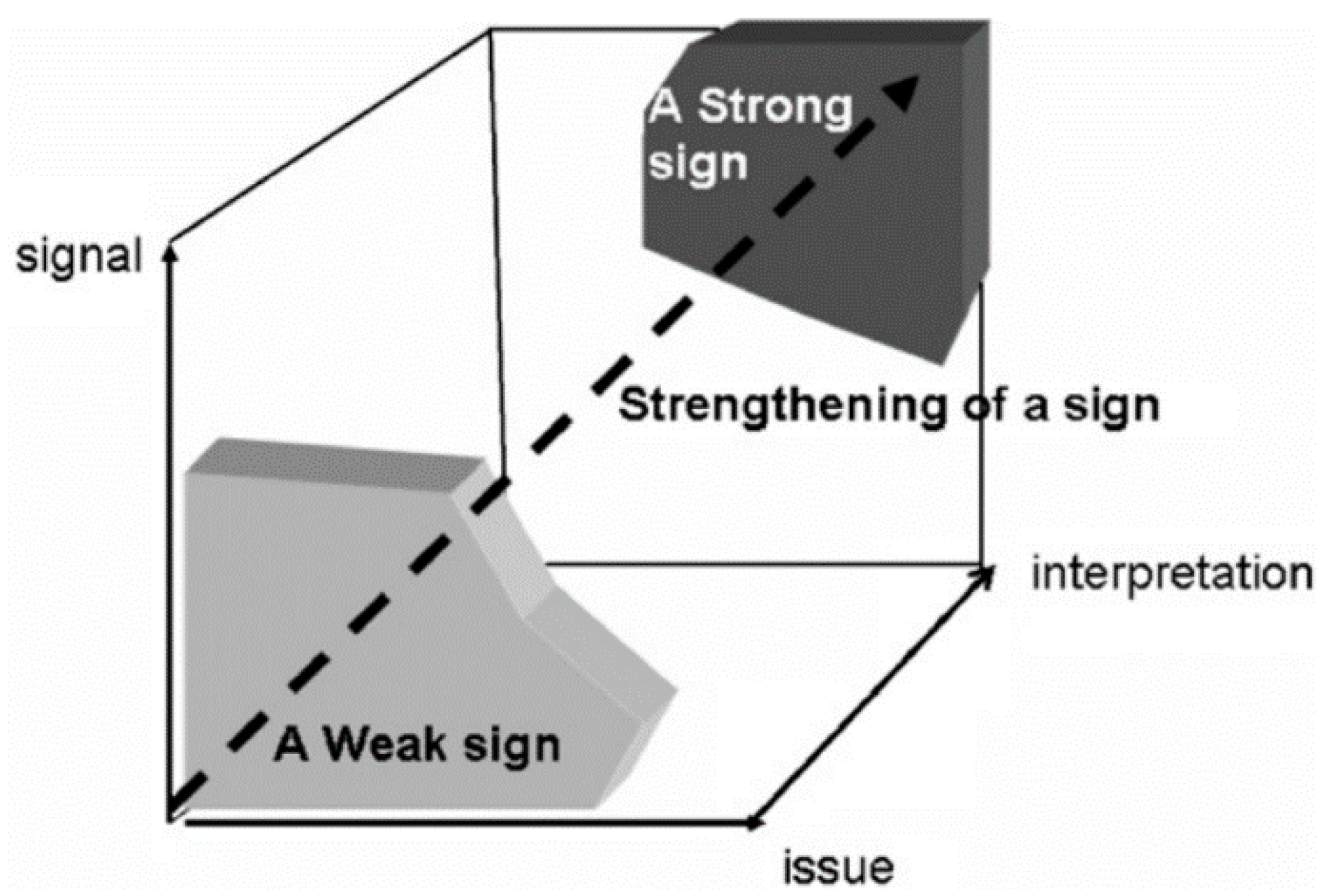

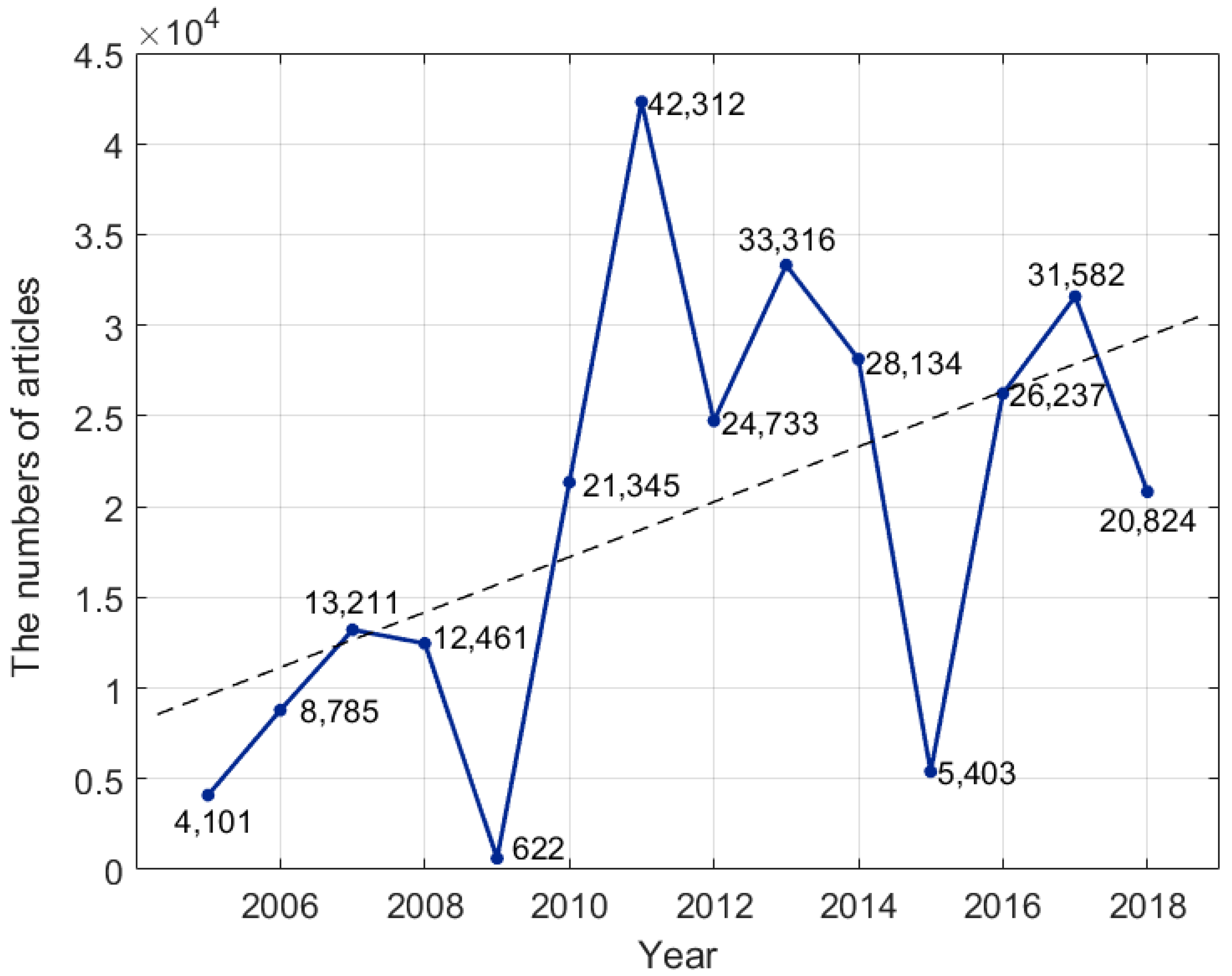
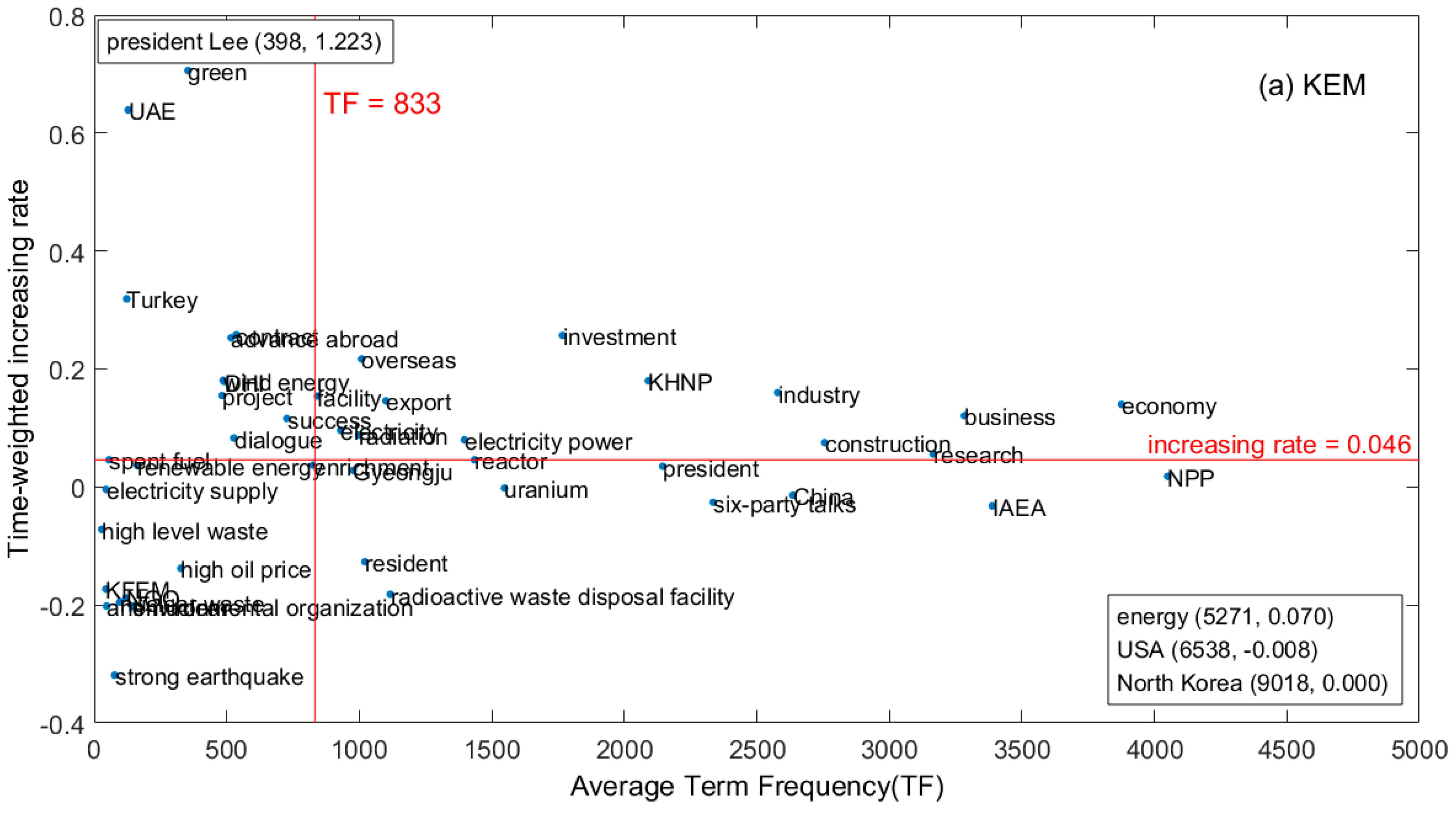
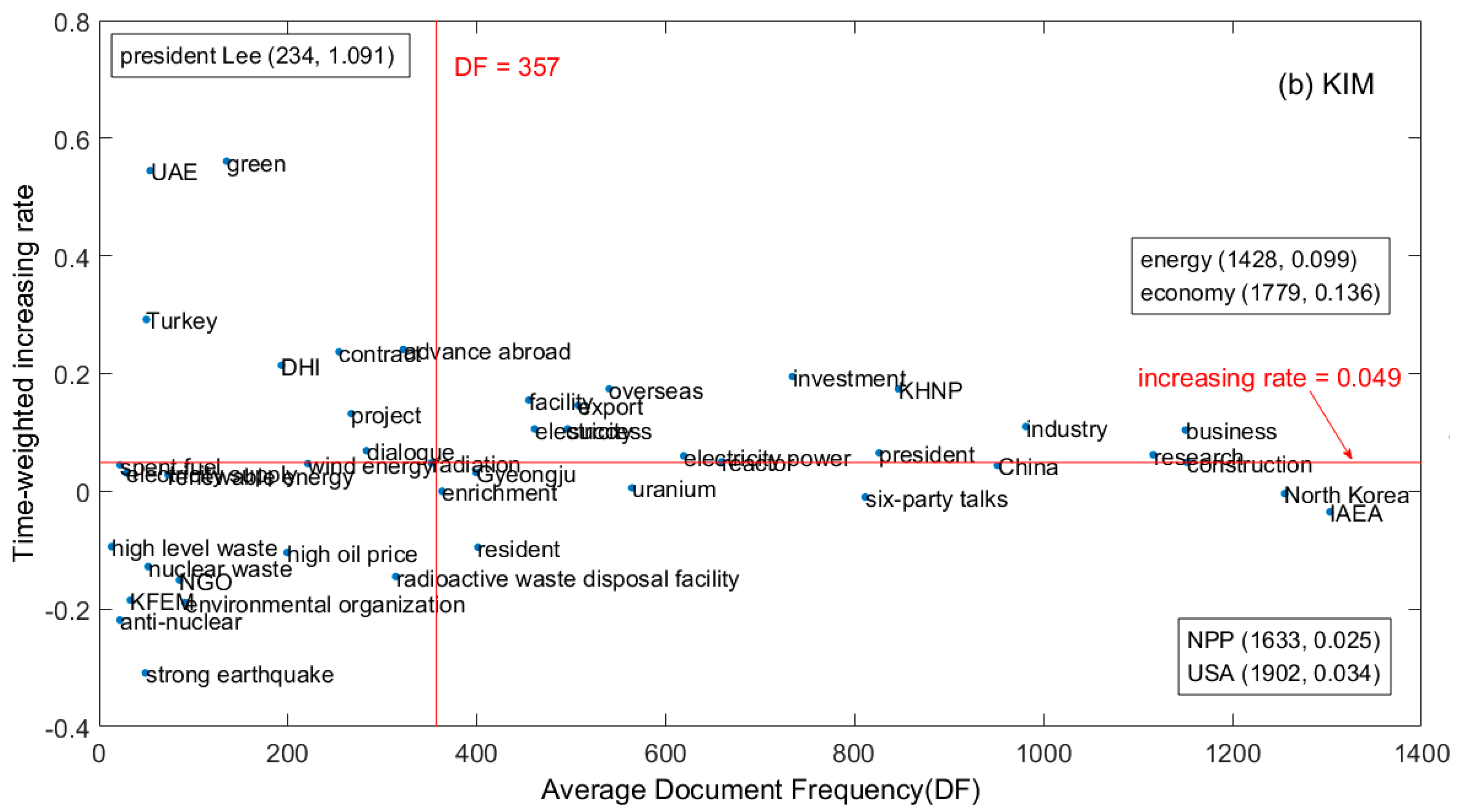

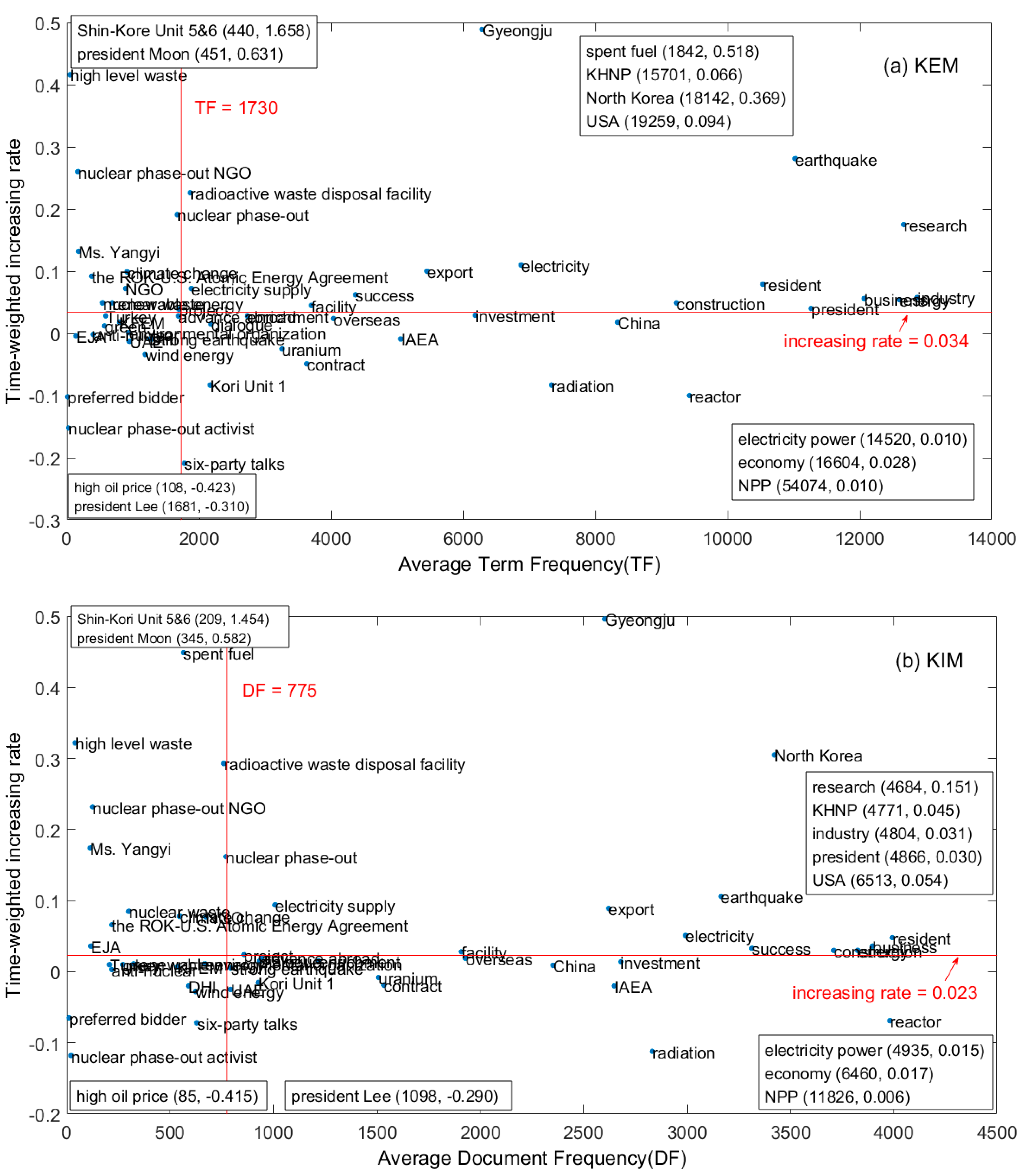
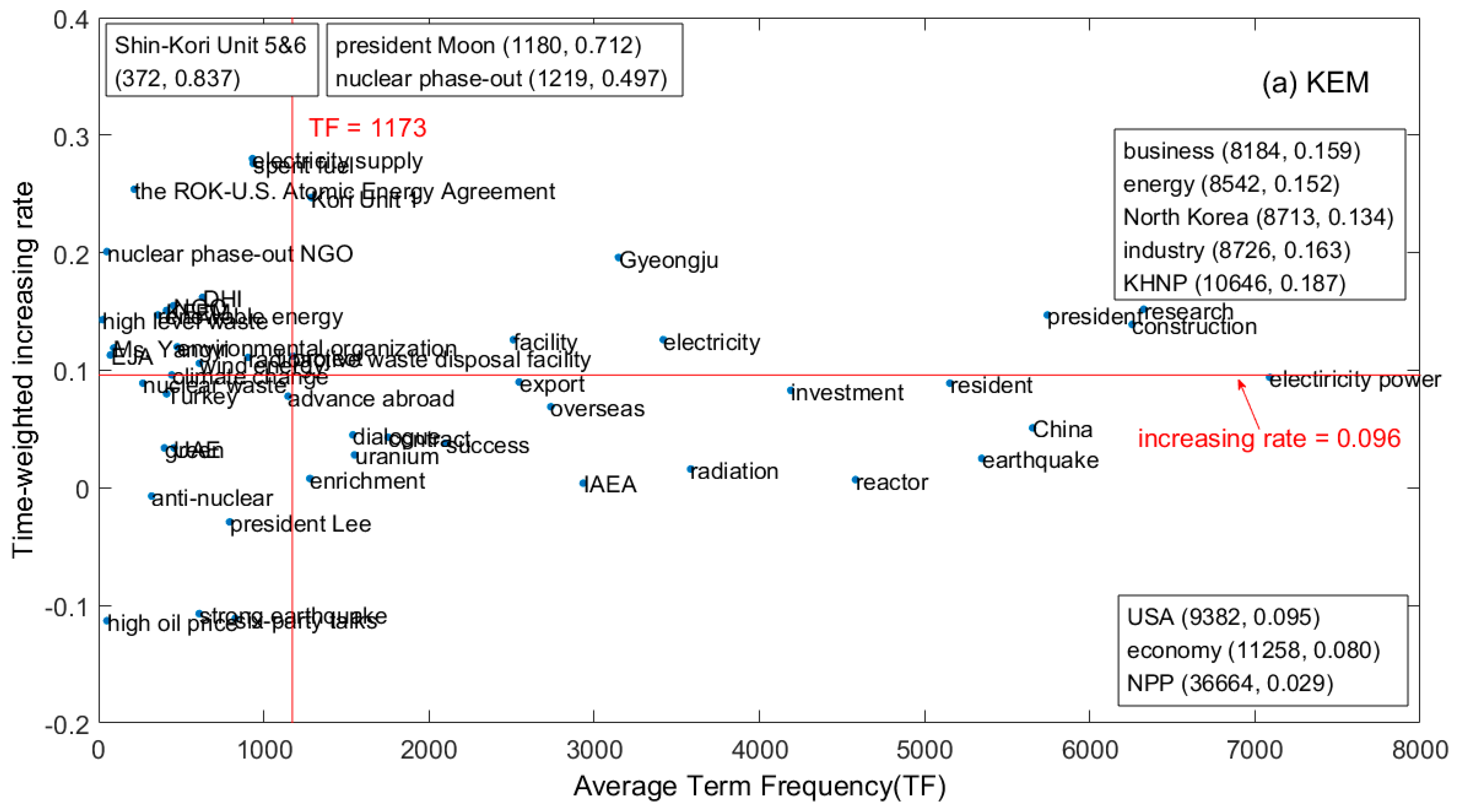

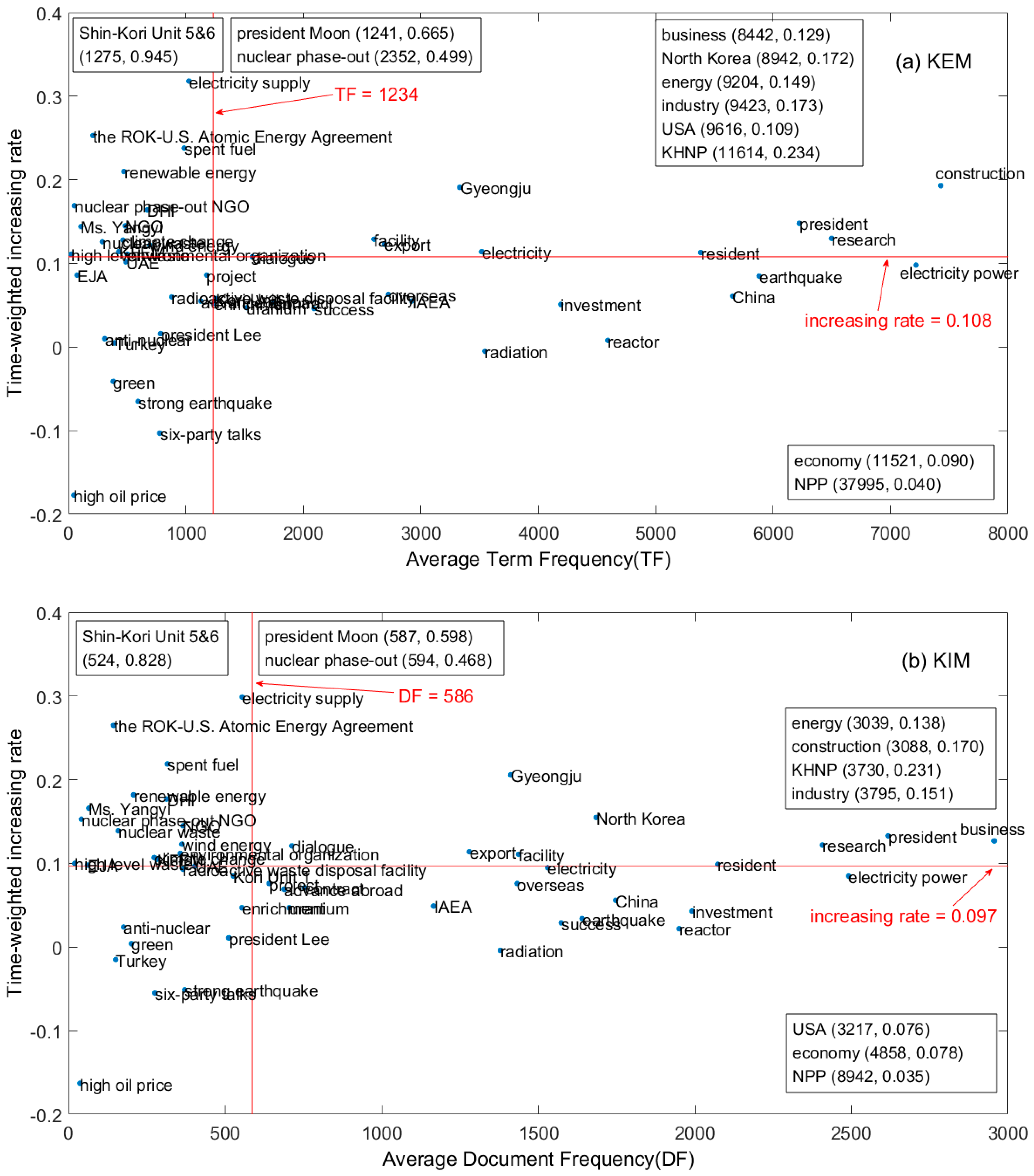
| Dimension | Weak Signal Topics | Strong Signal Topics |
|---|---|---|
| ‘Signal’ | advance abroad, contract, DHI(Doosan Heavy Industries & Construction), dialogue, green, president Lee, project, success, Turkey, UAE, wind energy | business, construction, economy, electricity power, electricity, energy, export, facility, industry, investment, KHNP(Korea Hydro & Nuclear Power), overseas, radiation, research |
| ‘Issue’ | advance abroad, contract, DHI, dialogue, green, president Lee, project, Turkey, UAE | business, construction, economy, electricity power, electricity, energy, export, facility, industry, investment, KHNP, overseas, president, reactor, research, success |
| Future signs | advance abroad, contract, DHI, dialogue, green, president Lee, project, Turkey, UAE | business, construction, economy, electricity power, electricity, energy, export, facility, industry, investment, KHNP, overseas, research |
| Dimension | Weak Signal Topics | Strong Signal Topics |
|---|---|---|
| ‘Signal’ | advance abroad, DHI, dialogue, electricity supply, enrichment, facility, green, president Lee, project, spent fuel, Turkey | business, China, construction, contract, economy, electricity power, electricity, export, Gyeongju, industry, investment, KHNP, overseas, research, success, UAE |
| ‘Issue’ | DHI, electricity supply, green, Gyeongju, president Lee, project, spent fuel, Turkey, wind energy | advance abroad, business, construction, contract, economy, electricity power, electricity, energy, export, facility industry, investment, KHNP, overseas, success, UAE |
| Future signs | DHI, electricity supply, green, president Lee, project, spent fuel, Turkey | business, construction, contract, economy, electricity power, electricity, export, industry, investment, KHNP, overseas, research, success, UAE |
| Dimension | Weak Signal Topics | Strong Signal Topics |
|---|---|---|
| ‘Signal’ | climate change, high level waste, Ms. Yangyi, NGO, nuclear phase-out, nuclear phase-out NGO, nuclear waste, president Moon, project, renewable energy, Shin-Kori Unit 5&6, the ROK–U.S. Atomic Energy Agreement | business, construction, earthquake, electricity, electricity supply, energy, export, facility, Gyeongju, industry, KHNP, North Korea, president, radioactive waste disposal facility, research, resident, spent fuel, success, USA |
| ‘Issue’ | climate change, EJA(Energy Justice Actions), high level waste, Ms. Yangyi, NGO, nuclear phase-out, nuclear phase-out NGO, nuclear waste, president Moon, radioactive waste disposal facility, Shin-Kori Unit 5&6, spent fuel, the ROK–U.S. Atomic Energy Agreement | business, construction, earthquake, electricity, electricity supply, energy, export, facility, Gyeongju, industry, KHNP, North Korea, president, project, research, resident, success, USA |
| Future signs | climate change, high level waste, Ms. Yangyi, NGO, nuclear phase-out, nuclear phase-out NGO, nuclear waste, president Moon, Shin-Kori Unit 5&6, spent fuel, the ROK–U.S. Atomic Energy Agreement | business, construction, earthquake, electricity, electricity supply, energy, export, facility, Gyeongju, industry, KHNP, North Korea, president, research, resident, success, USA |
| Dimension | Weak Signal Topics | Strong Signal Topics |
|---|---|---|
| ‘Signal’ | DHI, EJA, electricity supply, environmental organization, high level waste, KFEM(Korea Federation for Environmental Movements), Ms. Yangyi, NGO, nuclear phase-out NGO, radioactive waste disposal facility, renewable energy, Shin-Kori Unit 5&6, spent fuel, the ROK–U.S. Atomic Energy Agreement, wind energy | business, construction, electricity, energy, facility, Gyeongju, industry, KHNP, Kori Unit 1, North Korea, nuclear phase-out, president, president Moon, project, research |
| ‘Issue’ | climate change, DHI, EJA, electricity supply, environmental organization, KFEM, Kori Unit 1, nuclear phase-out NGO, nuclear waste, radioactive waste disposal facility, renewable energy, Shin-Kori Unit 5&6, spent fuel, the ROK–U.S. Atomic Energy Agreement, wind energy | business, construction, electricity, energy, facility, Gyeongju, industry, KHNP, North Korea, nuclear phase-out, president, president Moon, project, research |
| Future signs | DHI, EJA, electricity supply, environmental organization, KFEM, Ms. Yangyi, NGO, nuclear phase-out NGO, president Moon, radioactive waste disposal facility, renewable energy, Shin-Kori Unit 5&6, spent fuel, the ROK–U.S. Atomic Energy Agreement, wind energy | business, construction, electricity, energy, facility, Gyeongju, industry, KHNP, North Korea, nuclear phase-out, president, president Moon, project, research |
| Dimension | Weak Signal Topics | Strong Signal Topics |
|---|---|---|
| ‘Signal’ | climate change, DHI, electricity supply, environmental organization, high level waste, KFEM, Ms. Yangyi, NGO, nuclear phase-out NGO, nuclear waste, renewable energy, spent fuel, the ROK–U.S. Atomic Energy Agreement, wind energy | business, construction, electricity, energy, export, facility, Gyeongju, industry, KHNP, North Korea, nuclear phase-out, president, president Moon, research, resident, Shin-Kori Unit 5&6, USA |
| ‘Issue’ | climate change, DHI, EJA, electricity supply, environmental organization, high level waste, KFEM, Ms. Yangyi, NGO, nuclear phase-out NGO, nuclear waste, renewable energy, Shin-Kori Unit 5&6, spent fuel, the ROK–U.S. Atomic Energy Agreement, wind energy | business, construction, dialogue, energy, export, facility, Gyeongju, industry, KHNP, North Korea, nuclear phase-out, president, research, resident, USA |
| Future signs | climate change, DHI, electricity supply, environmental organization, high level waste, KFEM, Ms. Yangyi, NGO, nuclear phase-out NGO, nuclear waste, renewable energy, spent fuel, the ROK–U.S. Atomic Energy Agreement, wind energy | business, construction, energy, export, facility, Gyeongju, industry, KHNP, North Korea, nuclear phase-out, president, research, resident, USA |
© 2020 by the authors. Licensee MDPI, Basel, Switzerland. This article is an open access article distributed under the terms and conditions of the Creative Commons Attribution (CC BY) license (http://creativecommons.org/licenses/by/4.0/).
Share and Cite
Roh, S.; Choi, J.Y. Exploring Signals for a Nuclear Future Using Social Big Data. Sustainability 2020, 12, 5563. https://doi.org/10.3390/su12145563
Roh S, Choi JY. Exploring Signals for a Nuclear Future Using Social Big Data. Sustainability. 2020; 12(14):5563. https://doi.org/10.3390/su12145563
Chicago/Turabian StyleRoh, Seungkook, and Jae Young Choi. 2020. "Exploring Signals for a Nuclear Future Using Social Big Data" Sustainability 12, no. 14: 5563. https://doi.org/10.3390/su12145563
APA StyleRoh, S., & Choi, J. Y. (2020). Exploring Signals for a Nuclear Future Using Social Big Data. Sustainability, 12(14), 5563. https://doi.org/10.3390/su12145563





